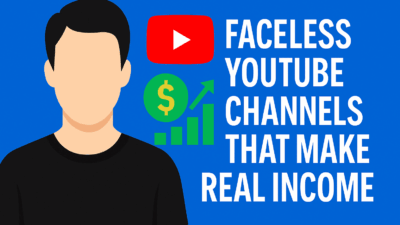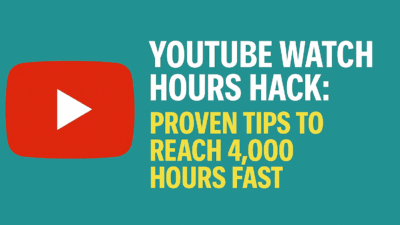Understanding RPM and CPM on YouTube in 2025 is essential if you’re serious about making money on the platform. These two metrics directly impact your earnings, and knowing how they work can help you optimize your content for maximum revenue.
In this guide, we’ll break down the difference between RPM and CPM, how they’re calculated, why they matter, and the strategies you can use to boost them. Whether you’re a beginner or an experienced creator, this post will provide real insights into the monetization game in 2025.
🌐 What is CPM on YouTube in 2025?
CPM, or Cost Per Mille, represents the amount advertisers are willing to pay for every 1,000 ad impressions on YouTube. It is one of the most important advertising metrics used by brands to gauge how much visibility they are getting for their money.
For example, if a brand runs a $500 campaign and gets 100,000 impressions, their CPM is $5. However, creators only receive a percentage of this since YouTube takes a 45% share of ad revenue.
For a detailed explanation, check the official YouTube Help page on CPM.
Also read our YouTube Monetization Requirements 2025 guide for beginners.
How CPM is Calculated
The CPM is calculated based on:
- The total amount an advertiser pays
- Divided by the number of impressions
- Multiplied by 1,000
Formula: CPM = (Advertiser Spend / Impressions) x 1000
Factors That Influence CPM
- Audience Geography: US and UK viewers bring higher CPMs than viewers from developing countries.
- Niche Topic: Content related to finance, legal advice, tech, and education usually has a higher CPM.
- Device Type: Desktop ads tend to pay more than mobile ads.
- Ad Engagement: Higher click-through rates and viewer engagement can increase CPM.
- Seasonality: CPMs are higher during Q4 due to Black Friday, Christmas, and New Year campaigns.
Some creators have even reported CPM spikes of over $20 during peak seasons in high-value niches!
📈 What is RPM on YouTube in 2025?
RPM, or Revenue Per Mille, is the total revenue a creator earns per 1,000 views on their channel. Unlike CPM, which focuses solely on ad impressions, RPM includes all revenue sources like:
- Ads (pre-roll, mid-roll, display, etc.)
- Channel memberships
- Super Chats during livestreams
- YouTube Premium revenue
- Affiliate links or third-party monetization (if integrated with YouTube’s features)
According to Google’s official YouTube Creator blog, RPM offers a more accurate view of a creator’s revenue potential.
Why RPM is More Useful for Creators
RPM gives you a much clearer picture of your actual earnings per view. It reflects what goes into your bank account after YouTube’s share and provides insight into how efficiently your content is monetizing.
Formula: RPM = (Total Revenue / Total Views) x 1000
If your total revenue for 50,000 views in a month is $125, your RPM is $2.50. This means you’re earning $2.50 per 1,000 views regardless of how many ads were served.
🥇 RPM vs CPM: Key Differences Explained
| Feature | CPM | RPM |
|---|---|---|
| Meaning | Advertiser spend per 1000 impressions | Creator earnings per 1000 views |
| Includes | Ad impressions only | Ads + memberships + Super Chats + Premium + more |
| Beneficiary | Reflects value to YouTube | Reflects value to creator |
| Seen in | AdSense reports | YouTube Analytics (Revenue tab) |
CPM is what advertisers pay. RPM is what you earn.
📊 Average RPM and CPM by Niche in 2025
| Niche | Avg CPM | Avg RPM |
|---|---|---|
| Finance | $15–$30 | $5–$12 |
| Tech Reviews | $8–$20 | $3–$6 |
| Health & Fitness | $5–$12 | $2–$4 |
| Gaming | $2–$6 | $0.50–$2.50 |
| Lifestyle/Vlogs | $3–$7 | $1–$2.50 |
| Education | $4–$10 | $1.50–$4 |
As you can see, some niches offer significantly more revenue than others. Choosing a profitable niche is one of the most effective ways to improve your RPM over time.
🚀 How to Increase RPM and CPM on YouTube in 2025
Boosting your earnings takes time, but there are specific strategies creators are using right now to raise their RPM and CPM levels:
1. Focus on Evergreen, High-Value Content
Videos that remain relevant over time (like tutorials, financial advice, or career tips) continue to bring in views and ad revenue for months or even years. Evergreen content is more attractive to advertisers.
2. Create Longer Videos (8+ Minutes)
Longer videos allow you to insert mid-roll ads. This increases your total ad impressions per view. Just make sure the video remains engaging throughout, or users will drop off before seeing those ads.
3. Optimize Your Titles and Thumbnails
Higher click-through rates lead to more views. More views equal more monetized impressions and RPM. Strong visuals and curiosity-based titles help a lot.
4. Encourage Community Engagement
The more likes, comments, and shares your video gets, the more likely it is to be boosted by the algorithm. More reach = more ad revenue.
5. Target High-CPM Topics
Even within your niche, some video ideas perform better than others. For instance, “How to Save for Retirement” will likely earn more than “My Daily Routine.”
6. Stay Consistent
Consistent uploads train your audience and the algorithm to expect regular value. This builds trust, increases viewership, and boosts RPM over time.
7. Experiment With Ad Types
Enable all ad formats unless you have a specific reason to block them. Some ads (like bumper ads or non-skippable ones) may offer better payout rates.
🔍 Monitoring RPM and CPM in YouTube Studio
To keep track of your monetization performance:
- Go to YouTube Studio
- Click Analytics > Revenue
- View your estimated RPM, CPM, monetized playbacks, and total revenue
Check this weekly and look for patterns. Which videos earned the highest RPM? What’s your RPM by geography? Adjust your strategy accordingly.
❓ FAQs
What’s a good RPM to aim for in 2025?
Anything above $3 is solid. In high-value niches, $5–$10+ is excellent.
Why is my RPM lower than expected?
It could be due to low advertiser demand in your niche, a large international audience with lower CPMs, or limited ad engagement.
Does RPM include affiliate earnings?
No. RPM only includes YouTube-based revenue. Affiliate income is tracked separately.
How often do RPM and CPM change?
They fluctuate daily based on market demand, your video performance, and audience behavior.
Can Shorts have CPM and RPM?
Yes, but YouTube Shorts use a pooled revenue share model that differs from traditional videos. CPMs for Shorts tend to be lower.
Mastering the difference between RPM and CPM on YouTube in 2025 isn’t just about numbers—it’s about making smart, informed decisions that grow your income. Keep creating valuable content, learn from your analytics, and focus on long-term growth.



